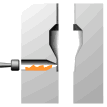
The process involves the use of a piston which traps a certain volume of molten metal and forces it into the die cavity through a nozzle. The pressure is maintained until the metal has solidified. Very high production rates.
Normally, metals with melting-points lower than steel are used. For low melting-point metals like zinc, tin and lead, hot chamber die casting is used. For other metals, cold chamber die casting is applied.
Danish Name
Category
Materials
Tin (Sn)
Lead (Pb)
Aluminium (Al)
Magnesium (Mg)
Copper (Cu)
Brass (Cu-Zn)
Typical products
Carburettor
ReferencesCeropa A/S
Dancast A/S
Linimatic A/S
Price notes
Formula suited for rough cost estimates (DKK/part) of pressure die casted components produced in medium to large volumes (>30,000 parts).
The formula includes post-machining and profit.
Photo
Copyright
This page is part of Design inSite
Disclaimer